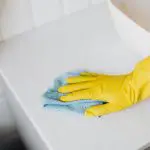Looking to master the art of removing blue stains from your white fabrics? Wondering how to tackle those stubborn marks effectively and efficiently? You're in the right place.
In this guide, we'll explore five quick and practical methods to banish those pesky blue stains for good. From lemon juice and salt to a hydrogen peroxide treatment, these techniques are designed to help you achieve spotless, pristine white fabrics.
No need to panic when faced with a blue stain – with these expert tips, you'll be equipped to handle them with ease.
Let's dive in and discover the best ways to restore your white fabrics to their pristine condition.
Key Takeaways
- Lemon juice and salt, vinegar soak can effectively remove blue stains from white fabrics.
- Baking soda paste followed by washing with color-safe bleach can restore the white color of stained fabric.
- Hydrogen peroxide treatment combined with baking soda paste is an effective method to remove blue stains.
- Dish soap and hydrogen peroxide solution can be used to remove blue stains, followed by thorough rinsing and air drying.
Lemon Juice and Salt
To remove blue stains from white fabrics, start by mixing lemon juice and salt in a small bowl. This natural cleaning method is effective for fabric stain removal and is a simple yet powerful solution. The acidity of the lemon juice helps to break down the blue stains, while the abrasive texture of the salt works to lift the stain from the fabric.
First, squeeze fresh lemon juice into a bowl and add a few teaspoons of salt. Mix the two ingredients to form a paste. Then, using a clean cloth or sponge, apply the lemon juice and salt paste directly onto the blue stains on the white fabric. Gently rub the paste into the stains, ensuring that the mixture covers the affected area completely.
Allow the lemon juice and salt paste to sit on the fabric for about 30 minutes to an hour. This gives the natural cleaning agents enough time to penetrate the fabric and break down the stain.
After the designated time, rinse the fabric with cold water and launder it as usual. You'll find that the blue stains have significantly faded or disappeared, leaving your white fabrics looking fresh and clean.
Vinegar Soak
You can remove blue stains from white fabrics by soaking the affected area in a mixture of vinegar and water. White vinegar benefits fabric stain removal due to its acidic nature, which helps break down and lift the stain from the fabric.
To utilize this method, mix one part white vinegar with two parts water in a basin or sink large enough to fully submerge the stained fabric. Allow the fabric to soak in the solution for 30 minutes to an hour, ensuring the stained area is completely submerged.
After the soaking period, gently rub the stained area to further loosen the blue stain. Once the stain appears to have lightened or disappeared, launder the fabric as usual.
This method is especially effective for removing blue stains from white fabrics, as the acidic properties of white vinegar work to neutralize and eliminate the discoloration. Remember to always check the fabric care label and perform a spot test in an inconspicuous area before treating the entire stained area.
Baking Soda Paste
Soak the stained white fabric in a mixture of baking soda and water to create a paste for removing blue stains. Baking soda is a powerful stain remover and can be effective in lifting blue stains from white fabrics. Start by mixing baking soda with water to form a thick paste. Apply the paste directly onto the stained area and gently rub it in. Let it sit for about 15 minutes to allow the baking soda to penetrate the fabric and lift the blue stain.
When using baking soda paste for stain removal, it's essential to focus on stain prevention as well. Address stains as soon as possible to prevent them from setting into the fabric. Additionally, consider using fabric color restoration techniques after removing the blue stain. This involves washing the fabric with a color-safe bleach to brighten and restore the white color of the fabric.
Baking soda paste offers an effective and natural solution for removing blue stains from white fabrics. By incorporating stain prevention and fabric color restoration techniques, you can effectively tackle blue stains and maintain the pristine appearance of your white fabrics.
Hydrogen Peroxide Treatment
After applying the baking soda paste and gently rubbing it in, consider using hydrogen peroxide treatment to further lift the blue stains from the white fabric.
Hydrogen peroxide is a powerful bleaching agent that can effectively remove stubborn stains. To use this treatment, mix one part hydrogen peroxide with two parts water. Apply the solution directly to the stained area and allow it to sit for 5-10 minutes. Then, gently blot the area with a clean cloth to lift the stain.
It's important to conduct a patch test on a hidden area of the fabric to ensure colorfastness and fabric color protection. Hydrogen peroxide is considered color safe for white fabrics, but it's crucial to check for any adverse reactions on colored fabrics.
After treating the stained area, wash the fabric as usual. Remember to follow the care label instructions and use the appropriate laundry detergent.
Once the fabric is clean, air dry it or tumble dry on low heat.
With careful application, hydrogen peroxide can be an effective solution for removing blue stains from white fabrics while maintaining fabric color protection.
Dish Soap and Hydrogen Peroxide Solution
Applying a mixture of dish soap and hydrogen peroxide is an effective way to further lift stubborn blue stains from white fabrics. To ensure fabric safety, always perform a patch test in an inconspicuous area to check for any adverse reactions.
Once confirmed, proceed by mixing one tablespoon of dish soap with two tablespoons of hydrogen peroxide. Gently dab the solution onto the stained area, allowing it to sit for 5-10 minutes. Afterward, use a clean, damp cloth to blot the area and lift the solution, along with the loosened stain, from the fabric. Avoid rubbing vigorously, as this can push the stain deeper into the fibers, making it more difficult to remove.
Rinse the treated area thoroughly with cold water and allow it to air dry. For tougher stains, consider repeating the process or seeking professional help to ensure the fabric's integrity.
This method provides a safe and effective way to tackle blue stains on white fabrics, and when done carefully, it can help maintain the fabric's quality and appearance.
Frequently Asked Questions
Can I Use These Methods on Delicate Fabrics Like Silk or Wool?
Yes, you can use these methods on delicate fabrics like silk or wool. However, be gentle and test a small, hidden area first. For silk care, use a mild detergent and cold water. For wool maintenance, use a wool-specific stain remover.
Will These Methods Work on Old, Set-In Blue Stains or Only Fresh Ones?
Old stains, even set-in ones, can be tough to remove from delicate fabrics like silk or wool. However, with a combination of methods, you can tackle stubborn stains without causing discoloration or damage to the fabric.
Are There Any Fabrics or Materials That I Should Avoid Using These Methods On?
When removing blue stains from white fabrics, avoid silk and wool, delicate materials. These methods could damage such fabrics. Stick to safer options like cotton or polyester to prevent ruining your garments.
Can I Combine Any of These Methods for More Stubborn Stains?
For stubborn stains, combining techniques can be effective. Try pre-treating with a stain remover, then using a mix of vinegar and baking soda. Follow with a cold water soak and wash. Always test on a small area first.
Will These Methods Cause Any Discoloration or Damage to the White Fabric?
To prevent damage or discoloration, consider using bleach alternatives and fabric care techniques. Avoid color transfer by testing on a small area first. Always follow precautions to preserve the white fabric's integrity.
- Aramid Ballistic Fabric: How Does It Stop a Bullet? - June 22, 2025
- Top 10 Aramid Fabric Manufacturers in the World - June 22, 2025
- How to Find a Reliable Aramid Fabric Supplier: A Checklist - June 22, 2025






